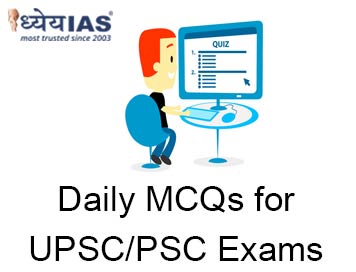Home > Daily-mcqs
Daily-mcqs 26 Apr 2025

Q1:
Which of the following are true regarding Haemophilia A? How many of the above statements are correct?
A: Only two
B: Only three
C: All four
D: Only one
Answer: B
Explanation:
Statements 2, 3, and 4 are correct. Haemophilia A is caused by a deficiency in Factor VIII, and due to its X-linked recessive inheritance, it is far more common in males. Prior to gene therapy, regular infusion of clotting factors was the standard treatment. Statement 1 is incorrect: it is X-linked, not autosomal. Thus, three statements are correct.
Q2:
Consider the following statements: Statement-I: The IMF’s World Economic Outlook is primarily focused on analyzing global poverty reduction initiatives. Which one of the following is correct?
Statement-II: The WEO assesses macroeconomic trends such as global growth, inflation, and financial stability.
A: Both Statement-I and II are correct and Statements II explains I
B: Statement-I is correct but Statement-II is incorrect
C: Statement-I is incorrect but Statement-II is correct
D: Both Statement-I and II are incorrect
Answer: C
Explanation:
The World Economic Outlook (WEO) deals with macroeconomic trends — such as GDP growth rates, inflation, debt dynamics, and financial stability. It does not focus primarily on poverty reduction; that is typically handled by World Bank or UNDP reports. Hence, Statement-I is incorrect, while Statement-II correctly describes the scope of WEO. The WEO helps policymakers forecast and adjust to shifts in the global economic environment.
Q3:
Match the following foodborne pathogens with the primary diseases they cause: Pathogen Disease A. Salmonella 1. Gastroenteritis B. Listeria monocytogenes 2. Listeriosis C. Clostridium botulinum 3. Botulism D. Escherichia coli (E. coli) 4. Kidney Failure
A: A-1, B-3, C-2, D-4
B: A-1, B-2, C-3, D-4
C: A-4, B-2, C-1, D-3
D: A-2, B-1, C-3, D-4
Answer: B
Explanation:
Each of the listed pathogens causes a distinct foodborne illness:
Q4:
Consider the following statements: Statement-I: The TRIPS Agreement mandates member countries to always prioritize patent protection over public health needs. Which one of the following is correct?
Statement-II: The Doha Declaration clarified that countries have the right to override patents to protect public health during emergencies.
A: Both Statement-I and II are correct and II explains I
B: Statement-I is correct but Statement-II is incorrect
C: Statement-I is incorrect but Statement-II is correct
D: Both Statement-I and II are incorrect
Answer: C
Explanation:
TRIPS (1995) initially raised concerns about restricting access to affordable medicines.
However, the Doha Declaration (2001) clarified that TRIPS should be interpreted to prioritize public health during emergencies (like pandemics), allowing measures like compulsory licensing.
Thus, Statement-I is incorrect (patents are not prioritized over health unconditionally), and Statement-II is correct.
Q5:
Consider the following facts regarding the Attari Integrated Check Post (ICP): How many of the above statements are correct?
A: Only two
B: Only three
C: All four
D: Only one
Answer: B
Explanation:
Statements 2 and 3 are correct. The Attari ICP provides direct access to National Highway 1, and India’s exports included straw reapers, while imports included gypsum.
However, Statement 1 is incorrect — truck movements began in 2007, and the ICP was formally inaugurated in 2012 (not 2005).
Statement 4 is also wrong — actual trade through Attari is around $2 billion annually, though the potential is $37 billion according to the World Bank.
Thus, only three statements are correct.